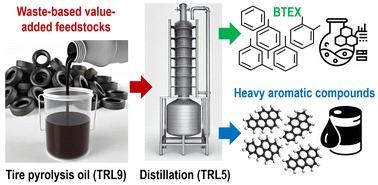来自轮胎热解油蒸馏的基于废物的增值原料:石化工业的脱石化
IF 9.2
1区 化学
Q1 CHEMISTRY, MULTIDISCIPLINARY
引用次数: 0
摘要
废物原料的回收是石化工业的一个重要步骤,从而也是循环经济中达到使用寿命的石油基产品(如报废轮胎)的一个重要步骤。这项工作是欧洲BLACKCYCLE项目的一部分,重点关注从工业规模工厂获得的轮胎热解油(TPO)的蒸馏性能,该工厂的技术成熟度排名第九(TRL-9)。在工业相关条件下,使用中试规模填充精馏塔,研究了不同再沸器温度和回流比对所得流的产率和特性的影响,该条件属于第5技术准备水平(TRL-5)。结果表明,该蒸馏过程能够连续生产含有高浓度苯、甲苯、乙苯和二甲苯(BTEX)的轻馏分(LF),适用于高价值化学品。同样,重馏分(HF)具有高C/H比,高闪点和高多环芳烃(PAH)的存在,使其成为炭黑油的有吸引力的替代品。这些结果对于实现基于废物的增值原料的回收,使ELT中的碳在石化工业中保留下来,是非常突出的。这项工作致力于开发绿色、经济实惠和实用的回收工艺,以填补可持续化学商品生产的空白,同时为解决该行业最大的挑战之一铺平道路:石化行业的去化石化。本文章由计算机程序翻译,如有差异,请以英文原文为准。

Waste-based value-added feedstocks from tire pyrolysis oil distillation: defossilization of the petrochemical industry†
The recovery of waste-based feedstocks is an important step in the defossilization of the petrochemical industry and thus in the circular economy for petroleum-based products that have reached the end of their useful life such as end-of-life tires (ELT). This work is part of the European BLACKCYCLE project, and focuses on the distillation performance of tire pyrolysis oil (TPO) obtained from an industrial scale plant, ranked at the ninth technology readiness level (TRL-9). The influence of different reboiler temperatures and reflux ratios on the yields and characteristics of the resulting streams was investigated using a pilot scale packed distillation column under industrially relevant conditions, classified within the fifth technology readiness level (TRL-5). The distillation process was shown to be capable of continuously producing a light fraction (LF) with a very high concentration of benzene, toluene, ethylbenzene and xylenes (BTEX) suitable for high value chemicals. Similarly, a heavy fraction (HF) with a high C/H ratio, high flash point and high presence of polycyclic aromatic hydrocarbons (PAH) is obtained, making it an attractive alternative to carbon black oil. These results are quite outstanding to accomplish the recovery of waste-based value-added feedstocks in such a way that the carbon embedded in the ELT is retained in the petrochemical industry. This work is committed to the development of green, affordable and practical recycling processes to fill the gap in the production of sustainable chemical commodities, while paving the way to address one of the industry's greatest challenges: the defossilization of the petrochemical industry.
求助全文
通过发布文献求助,成功后即可免费获取论文全文。
去求助
来源期刊

Green Chemistry
化学-化学综合
CiteScore
16.10
自引率
7.10%
发文量
677
审稿时长
1.4 months
期刊介绍:
Green Chemistry is a journal that provides a unique forum for the publication of innovative research on the development of alternative green and sustainable technologies. The scope of Green Chemistry is based on the definition proposed by Anastas and Warner (Green Chemistry: Theory and Practice, P T Anastas and J C Warner, Oxford University Press, Oxford, 1998), which defines green chemistry as the utilisation of a set of principles that reduces or eliminates the use or generation of hazardous substances in the design, manufacture and application of chemical products. Green Chemistry aims to reduce the environmental impact of the chemical enterprise by developing a technology base that is inherently non-toxic to living things and the environment. The journal welcomes submissions on all aspects of research relating to this endeavor and publishes original and significant cutting-edge research that is likely to be of wide general appeal. For a work to be published, it must present a significant advance in green chemistry, including a comparison with existing methods and a demonstration of advantages over those methods.
 求助内容:
求助内容: 应助结果提醒方式:
应助结果提醒方式:


